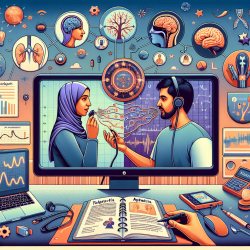Introduction
In the complex tapestry of factors influencing the mental health and behavior of Black youth, religion emerges as a significant protective element. The recent study titled "The Relationship between Religion, Substance Misuse, and Mental Health among Black Youth" offers insightful data that can guide practitioners in enhancing their therapeutic approaches. This blog post will delve into the study's findings and discuss how they can be applied to improve outcomes for Black youth, particularly in the context of online therapy services like those provided by TinyEYE.
Key Findings of the Study
The study, informed by Critical Race Theory, evaluated correlations between gender, depression, substance misuse, and religiosity among Black youth. The researchers used multiple linear regression to assess self-reported measures of drug use, sexual behavior, belief in God, and religiosity on mental health among a sample of Black youth living in a large Midwestern city. Key findings include:
- Drug use and sex while on drugs and alcohol were significantly associated with increased mental health symptoms.
- Belief in God was negatively associated with having sex while on drugs and alcohol, suggesting a protective role of religiosity.
- Despite structural inequalities, religion continues to act as a buffer against prevalent problem behaviors among Black youth.
Implications for Practitioners
Practitioners working with Black youth can leverage these findings to enhance their therapeutic strategies. Here are some actionable steps:
- Incorporate Spirituality into Therapy: Recognize the role of spirituality and religious beliefs as protective factors. Encourage discussions around faith and spirituality in therapy sessions to help youth navigate challenges.
- Community Engagement: Collaborate with local religious organizations to create supportive networks for youth. These organizations can provide social capital and emotional support, which are crucial for mental well-being.
- Address Structural Inequalities: Be aware of the systemic barriers that Black youth face and advocate for changes at the community and policy levels to improve access to mental health resources.
Encouraging Further Research
While the study provides valuable insights, it also highlights the need for further research. Practitioners and researchers should consider exploring:
- The role of different aspects of religiosity, such as personal spirituality versus organized religious involvement, in mental health outcomes.
- The impact of digital and social media-based religious communities on youth's mental health and behavior.
- The intersectionality of race, gender, and socioeconomic status in shaping the mental health experiences of Black youth.
Conclusion
Understanding the protective role of religion in the lives of Black youth can significantly enhance therapeutic outcomes. By integrating these insights into practice, practitioners can better support the mental health and well-being of Black youth, helping them to thrive despite the challenges they face. For those interested in a deeper dive into the research, the original study can be accessed through this link: The Relationship between Religion, Substance Misuse, and Mental Health among Black Youth.










